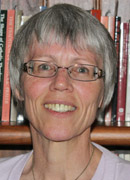By Barb Arland-Fye

A faith-sharing opportunity arose while I huddled with three women in an ice arena watching our relatives play sled hockey. One of the women, a Protestant, asked me about the role and duties of deacons in the Roman Catholic Church. Another woman, who is Catholic, offered her perspective of the diaconate, but didn’t address a deacon’s role regarding the sacraments. That led to a brief discussion about why the Catholic Church places such great value on the seven sacraments.
Reflecting on the conversation later that night, I realized how woefully inadequate my contribution had been toward furthering an understanding of and appreciation for the sacraments. Hesitancy in sharing my Church’s teachings face to face with casual acquaintances dates back to my days working for the secular press. The example set by Pope Francis, who is comfortable sharing the Gospel with people of faith or no faith, should have served as my guide.
With such confidence, I could have shared with my acquaintances a reminder of the greatest gift of our faith: God so loved the world that he sent his only son to live among us. Through the mystery of the Incarnation, Jesus became human. He had the same need for food, water, shelter, clothing and love that we do.
Since we relate to each other by sight, hearing, touch, smell and taste, the Catholic Church employs signs and symbols to express the sacraments. We use materials of the earth with which we are intimately familiar: water, oil, candles, bread and wine. This is how we make the connection between the human and the divine.
A friend shared a story recently, joking about how a mischievous preschooler “practically drowned” in the full-immersion baptismal at her church. Baptism is both dying and being born into new life with Christ through the symbol of water, the essence of life.
“The Introduction to the Rite of Baptism for Children” states that if possible baptism of children should take place on Sunday, the day the Church celebrates the paschal mystery, and that the sacrament ought to be conferred in a communal celebration in the presence of the faithful. Witnessing baptism during Sunday Mass is incredibly moving. We come together — related not by blood, but by our Christianity — to celebrate, affirm and support the nuclear family that has pledged to raise this beloved child to know and love God in a community of faith. Baptism reminds us that we are on a journey to the fullness of our salvation, and that dying to the sinful part of ourselves is a requirement.
In explaining Catholic teaching on the Eucharist to my acquaintances at the sled hockey game, I should have shared a story or two of my experience of Eucharist. I am drawn to the Eucharistic Prayer, in which the priest gives voice to the Church’s prayer of remembrance, invoking the Holy Spirit on the gifts of bread and wine. We believe that these gifts become the body and blood of Christ. By embracing this transformation, we too are transformed.
I’ve had the privilege on occasion of attending Mass at nursing homes such as The Alverno in Clinton and the Kahl Home in Davenport. It is truly a sacred moment to watch the presiding priest and the Sisters bring Communion to residents in their wheel chairs or seats in the chapel. Age has taken a toll, but the residents’ participation in the Eucharist provides them with an encounter with Christ that sustains them on the journey. They cherish that encounter.
Whenever I am about to receive Communion, I strive to set aside all distractions and concentrate on receiving the body and blood of Jesus Christ into my very being. Jesus becomes a part of me and I become a part of Jesus. His gift of self ought to, in turn, become my gift of self to others in my daily life. That’s what I needed to share with my acquaintances at sled hockey.







